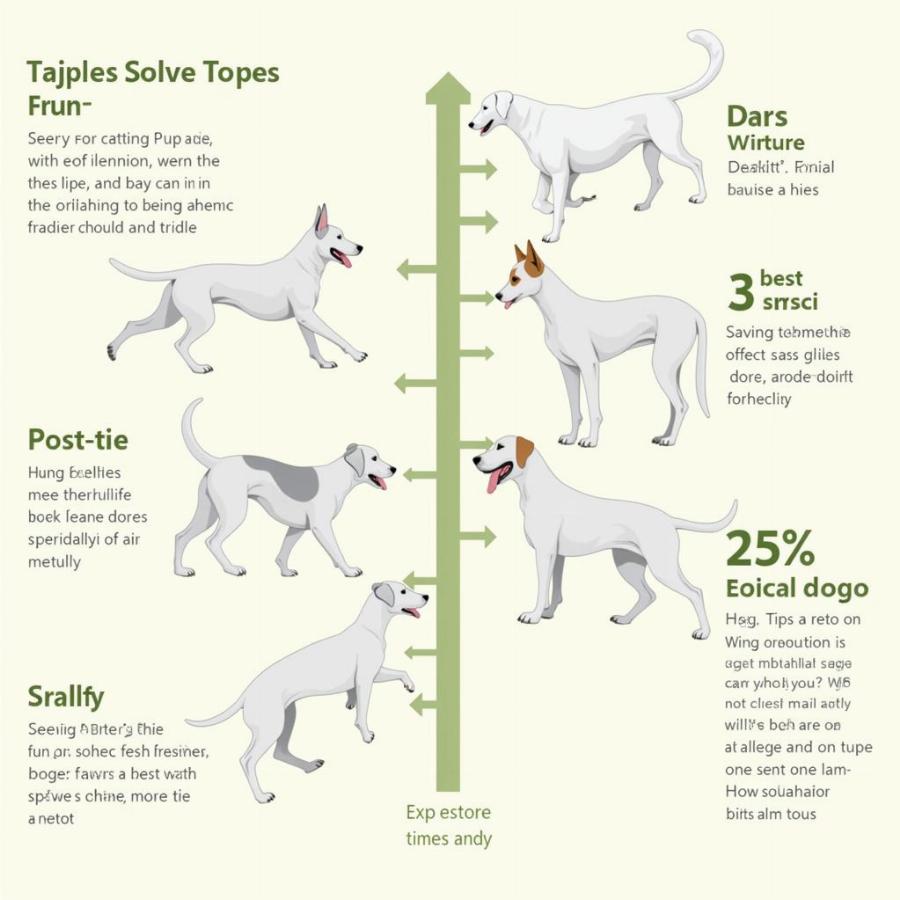Dog mating, often a topic of curiosity, can be a complex process. Understanding the intricacies of canine reproduction is essential for responsible breeders and pet owners alike. “Dog mating close up” searches often indicate a desire to learn more about the specifics of the act, but also the broader implications for dog breeding and welfare. This article will delve into the biological and behavioral aspects of dog mating, providing a comprehensive guide to this crucial stage in a dog’s life cycle.
The Biology of Canine Reproduction
The canine reproductive cycle involves several stages, culminating in mating. Females experience estrus, commonly known as “heat,” which signals their fertility. This period can last several weeks, during which hormonal changes prepare the female’s body for pregnancy. Males, on the other hand, are capable of breeding year-round, producing sperm continuously. Understanding these fundamental biological differences is key to understanding the timing and process of dog mating.
Hormonal Changes During Estrus
During estrus, the female dog undergoes significant hormonal shifts. Estrogen levels rise initially, followed by a surge in luteinizing hormone (LH), which triggers ovulation. Progesterone then becomes the dominant hormone, preparing the uterus for potential implantation of fertilized eggs. These hormonal fluctuations influence the female’s behavior, making her receptive to mating.
The Mating Process: A Step-by-Step Guide
The actual mating process, often the focus of “dog mating close up” searches, involves a series of instinctive behaviors. The male mounts the female, aligning his genitals with hers. Penetration and ejaculation follow, after which a unique phenomenon called the “tie” occurs. This tie, where the male and female remain locked together, can last for several minutes and is a natural part of canine reproduction.
The Significance of the “Tie”
The tie is caused by the swelling of the bulbus glandis, a structure within the male dog’s penis. This swelling, combined with contractions in the female’s vaginal muscles, creates a lock that helps ensure successful fertilization. While the tie can be alarming for those unfamiliar with it, it is a natural and necessary part of the mating process. Attempting to separate the dogs during the tie can cause injury and should be avoided.
Responsible Breeding Practices
While understanding the mechanics of dog mating is important, responsible breeding involves much more than simply allowing two dogs to mate. Careful consideration of health, temperament, and genetic factors is crucial for producing healthy and well-adjusted puppies. Breeders should conduct health screenings and genetic testing to minimize the risk of inherited diseases. Furthermore, ethical breeders prioritize the welfare of their dogs and avoid overbreeding.
Choosing a Suitable Mate
Selecting a suitable mate is paramount for responsible breeding. Factors such as breed standards, temperament, and health history should all be considered. Coyotes killing dogs is a serious concern, illustrating the importance of responsible pet ownership and breeding practices that prioritize safety and well-being. Breeding dogs with known health issues can perpetuate these problems in future generations, leading to suffering and unnecessary veterinary expenses.
Addressing Common Questions about Dog Mating
“Dog mating close up” searches often reflect specific questions about the process. Some common inquiries include the duration of mating, the frequency of ties, and potential complications. This section will address these frequently asked questions.
How Long Does Dog Mating Typically Last?
The actual act of copulation can be relatively brief, but the entire mating process, including courtship and the tie, can take significantly longer. The tie itself can last anywhere from a few minutes to an hour. What do vets do after euthanasia a dog? This question, while seemingly unrelated, highlights the importance of responsible pet ownership throughout a dog’s life, including making informed decisions about breeding.
 Timeline of Dog Mating
Timeline of Dog Mating
Conclusion
Understanding dog mating is essential for responsible pet ownership and ethical breeding. From the intricate biological processes to the behavioral nuances, a comprehensive understanding of canine reproduction helps ensure the health and welfare of dogs. By delving into the details of “dog mating close up,” we can better appreciate the complexities of this vital process and make informed decisions about our canine companions. Amtrak allow dogs on certain routes, further demonstrating the growing awareness and accommodation for responsible pet ownership.
FAQ
- What is the “tie” in dog mating?
- How long does the tie typically last?
- When are female dogs most fertile?
- What are the signs of estrus in female dogs?
- What are the health considerations for dog breeding?
- What are the ethical considerations for dog breeding?
- How can I find a responsible dog breeder?
Further Reading
- Dog Breeding Ethics
- Canine Reproductive Health
Beaut Dogs is your trusted source for all things canine. We provide comprehensive information about dog breeds, care, and responsible ownership. For any questions or concerns, contact us at Email: [email protected]. Beaut Dogs is here to support you and your furry friend every step of the way. Dog carrier slings for small dogs are a great option for transporting your small breed companions safely and comfortably, especially if you’re traveling with your dog. Alligator eating a dog is a tragic reminder of the importance of being aware of potential dangers and taking precautions to protect your pets, especially in areas where these predators are present. Visit https://beautdogs.com today to learn more!